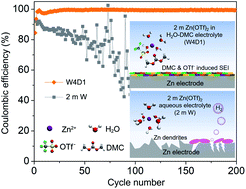Abstract
Rechargeable aqueous zinc batteries (RAZBs) are promising for large-scale energy storage because of their superiority in addressing cost and safety concerns. However, their practical realization is hampered by issues including dendrite growth, poor reversibility and low coulombic efficiency (CE) of Zn anodes due to parasitic reactions. Here, we report a non-concentrated aqueous electrolyte composed of 2 m zinc trifluoromethanesulfonate (Zn(OTf)2) and the organic dimethyl carbonate (DMC) additive to stabilize the Zn electrochemistry. Unlike the case in conventional aqueous electrolytes featuring typical Zn[H2O]62+ solvation, a solvation sheath of Zn2+ with the co-participation of the DMC solvent and OTf− anion is found in the formulated H2O + DMC electrolyte, which contributes to the formation of a robust ZnF2 and ZnCO3-rich interphase on Zn. The resultant Zn anode exhibits a high average CE of Zn plating/stripping (99.8% at an areal capacity of 2.5 mA h cm−2) and dendrite-free cycling over 1000 cycles. Furthermore, the H2O + DMC electrolytes sustain stable operation of RAZBs pairing Zn anodes with diverse cathode materials such as vanadium pentoxide, manganese dioxide, and zinc hexacyanoferrate. Rational electrolyte design with organic solvent additives would promote building better aqueous batteries.

- This article is part of the themed collections: Celebrating 15 years of exceptional research in Chemical Science, Editor’s Choice: Zaiping Guo, Materials & Energy in Chemical Science - most popular articles 2021, Celebrating 100 Years of Chemistry at Nankai University and Battery science and technology – powered by chemistry


 Please wait while we load your content...
Please wait while we load your content...